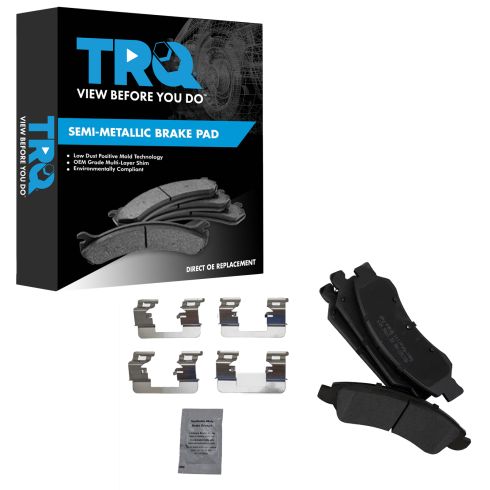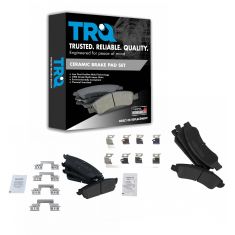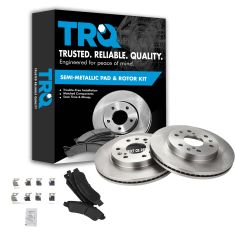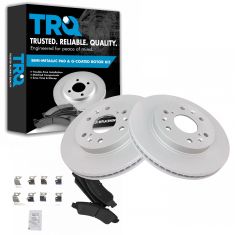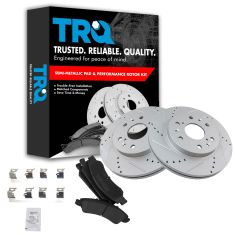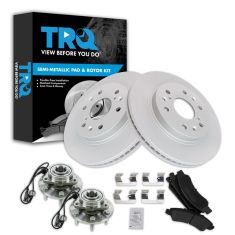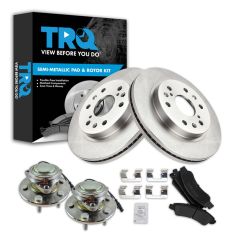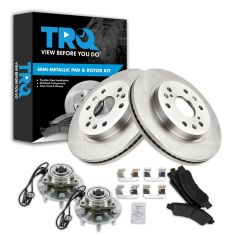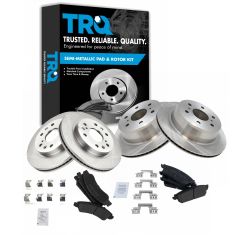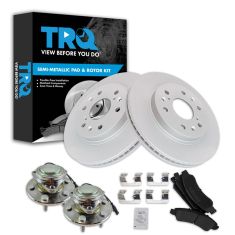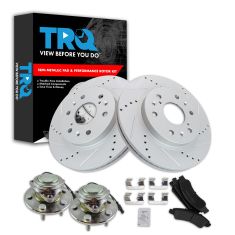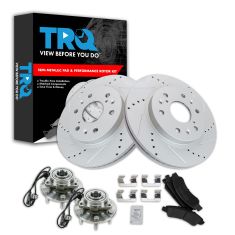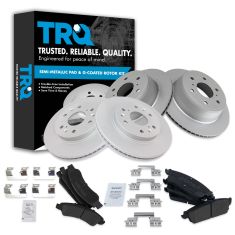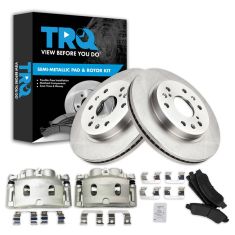Brought to you by 1AAuto.com, your source for quality replacement parts and the best service on the Internet.
Hi, I'm Mike from 1A Auto. I hope this how-to video helps you out, and next time you need parts for your vehicle, think of 1AAuto.com. Thanks.
In this video, we're going to show you how to service the front brakes on this 2011 Chevy Silverado. It's the same procedure for this truck from 2007 to 2013 Chevy Silverado as well as the GMC Sierra. This is the 1500. We're going to show you on the right-hand or passenger side. The left-hand or driver side is the same, and we do always recommend that you service your brakes in pairs. You'll need new brake rotors and pads from 1AAuto.com, jack and jack stands, 18mm to 22mm sockets and ratchet, breaker bar or pipe for some extra leverage since a couple of those bolts are pretty tight, and a T30 Torx bit and driver. If you have some rust you may need a couple of M10 bolts to help you get the disc or the rotor off. You'll also need a wire brush, brake or white grease, and a large C-clamp.
Remove the center cap just by prying with a screwdriver. If you don't have the benefit of air tools, loosen the lug nuts with the vehicle on the ground, then raise and secure the vehicle and then remove the lug nuts the rest of the way. Remove the wheel and tire. They are 22mm lug nuts.
By hand or using a steering wheel, turn so you can access the back of the caliper. Now check for any abnormal wear. Make sure that the inside and outside pads are warn about the same amount. Also on the rotor, make sure there are no deep grooves or uneven wear. This can indicate other problems with your brake system.
There are two 19mm bolts that hold the caliper on: up there and there. We'll fast-forward as we use a 19mm socket and ratchet to remove those bolts. Once you have your bolts off, just put the caliper up an out of the way. Use a screwdriver and pry the brake pads out. You can see the outer one comes out pretty easily. We have a little trouble with the inner one. We actually switched to a larger screwdriver, and you can see after a little more force it comes out.
Now this brake pad sticking in there like that indicates there's a problem, and you want to do some cleanup and some lubrication to prevent this. Remove the little stainless steel slides from the caliper bracket. There are two 18mm bolts that hold the caliper bracket to the steering knuckle: there and there. You can see here, we give it a try with just the socket and ratchet, but then we use a pipe for some extra leverage and loosen up that bottom one. Then we'll loosen up the top one, remove the bolts, and remove that caliper bracket. There's a T30 Torx screw that holds the rotor to the hub, and we're just using a T30 Torx bit with the ratchet to remove that.
Then, on this truck, the rotor actually pulls off quite easily. If your rotor doesn't come off easily, make sure you douse the back side with penetrating oil as well as around the studs. Use two M10 bolts, and you can tighten them up through the threaded holes and press the rotor off. Here you see old brakes on the left and new brakes from 1A Auto on the right. They're exactly the same.
The inner pad does have a straight edge at the bottom. Put the new rotor in place and then we just use a lug nut to put it in place, kind of just holds things together while you assemble it. Use a wire brush and clean out the grooves where the brake pads go in the caliper brackets. The slide bolts should move in and out nice and easy. If they don't, you can pull them out, clean them, and grease them. Here we are reinstalling the stainless steel slides into the caliper bracket. Then we'll use a wire brush to clean those as well.
We'll continue to fast-forward as we put the caliper bracket in place and start the two bolts that hold it in place. Then tighten them up preliminarily. Use the Torx wrench to tighten those up to 100 foot-pounds. Use brake grease or white lithium grease, and then grease the ends of the pads where they'll sit in the caliper brackets. You can use mineral spirits, or brake cleaner, even gasoline, anything that evaporates quickly and clean up your brakes before putting the rest of them back together.
Put the rear pad in first. Put one side in first and then press the other side in. Make sure it's going fairly easily, and the same thing for the front pad. Now you need to reset the caliper piston. We've put the old inner brake pad back in there, and I'm just going to use a large C-clamp, and as we tighten it up you'll see the pistons go back into the caliper. Now put the caliper back in place. Sometimes those slide bolts will get stuck a little bit, so you have to push them in a little bit to get the caliper to slide down in correctly. Put the caliper in place and start the two bolts on that hold it. We're going to Torx these two bolts to 50 foot-pounds.
Fast-forward as we remove that lug nut and then put our wheel back on. Put the lug nuts back on by hand first, then tighten them up preliminarily, and with the vehicle back down on the ground, secure and tighten those lugs. Torque the lug nuts to about 110 foot-pounds using a crossing pattern. There's a groove on the wheel and there's another tongue in the cap that line it up. Put the cap back on.
Most importantly, pump your brakes up and do test stops from five and ten mph. Make sure everything is working correctly before you road test your vehicle.
We hope this video helps you out. Brought to you by www.1AAuto.com, your source for quality replacement parts and the best service on the Internet. Please feel free to call us toll-free, 888-844-3393. We're the company that's here for you on the Internet and in person.
